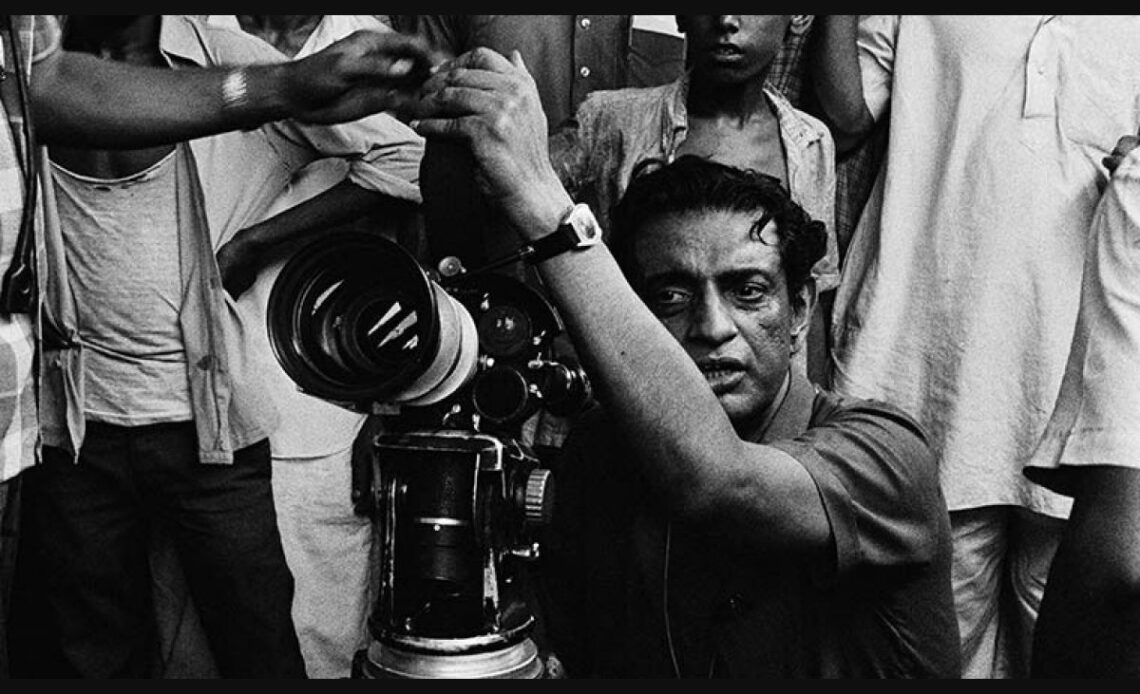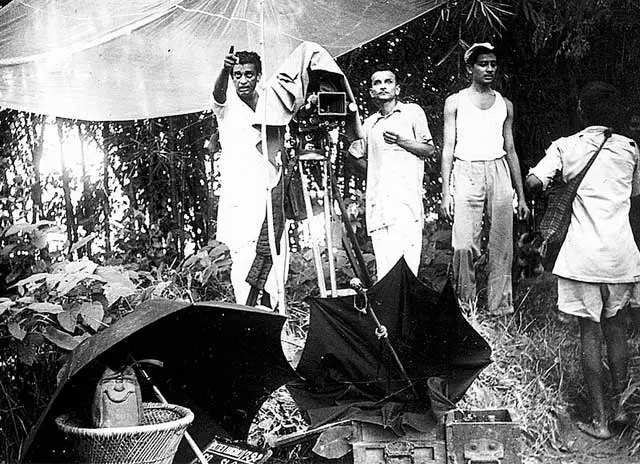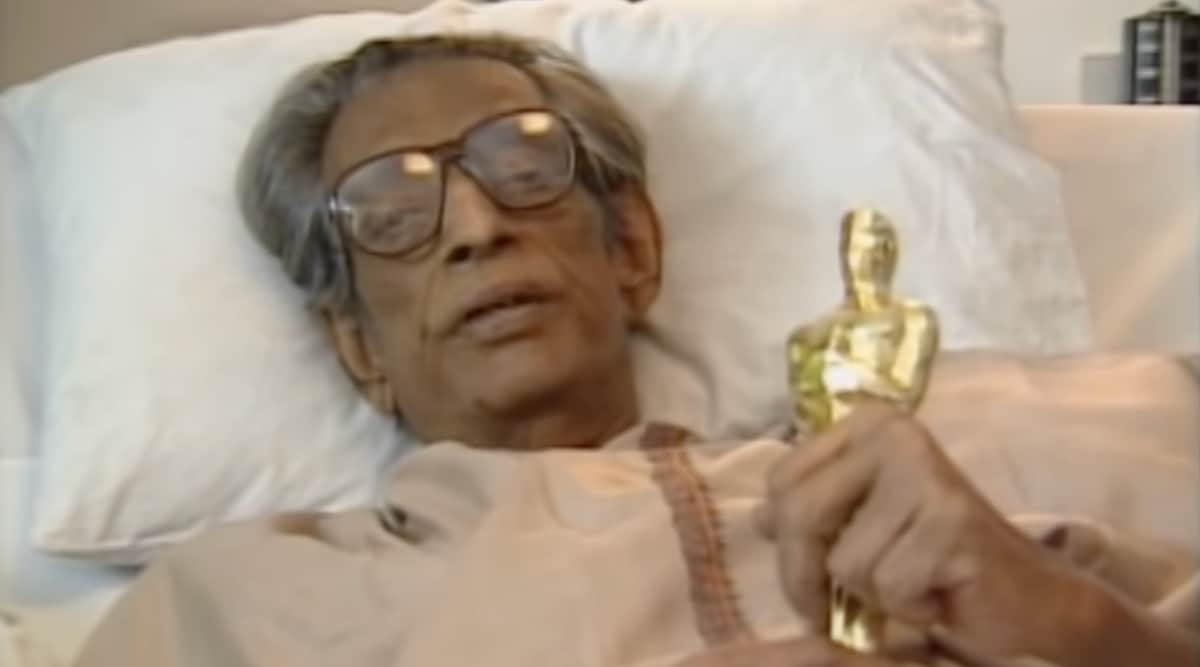
Pather Panchali, a movie made around 70 years ago, still holds relevance if one watches it. And so is the case with almost all the movies of Satyajit Ray. So today I will be talking about the movies of Satyajit Ray. What made his movies revolving around the simplest of themes so special, and the different and revolutionary aspects of filmmaking that he introduced, and what hidden messages he conveyed. My focus would be primarily on Pather Panchali, but the readers will get an insight into Ray’s cinema. And what a pretty coincidence it is, that my blog comes just two days after the 101st birth anniversary of the maestro.
A Brief Biography of the Maestro
Satyajit Ray was born in Garpar Road, Kolkata. His family had an ancestral printing press and blockmaking house. From the very childhood, he was brought up in a traditional ‘Bengali’ fashion, which meant he had a special inclination towards art and culture. Ray was indeed involved in all sorts of activities. He and his mother liked singing. He was also into drawing, sketching, and painting, so much so, that initially, he dreamt of being a professional artist only. But, slowly the time of cinema came, and he started getting influenced by Western cinema.
Heading on to college, Ray’s interest titled towards the directorial aspects of filmmaking. He started looking up to directors like John Ford, Ernst Lubitsch, William Wyler, and Frank Capra. In Ray’s own words, “My education of films is actually based on these well crafted, well-written, well-directed and well-acted movies of the 1930s and 40s”.
Ray had formed a Bengali Film Society and used to have discussions on movies. At that time, one of the landlords had thrown them out of his house saying they were ‘polluting’ the atmosphere of the house. Ray was so much into teh Western cinema, that just through the scene or the music, he was able to say which production house and director has made it.
In the early 1950s, Ray was just a normal person with a tremendous passion for movies, but working in an advertising company. He was sent to Europe by his company, as part of a company tour along with his wife. Now, this turned out to be the very point that changed Ray’s life once and for all. During his tour, he watched 99 European movies and got further deeply influenced by them. The movie that left the strongest impact on the filmmaker was The Bicycle Thieves (do watch it if you haven’t already).

A still from Pather Panchali (Photo: Wolfcrow)
The Making of Pather Panchali
Then comes the year 1953. A director named Jean Renoir had come to Calcutta to do the recce of his movie ‘The River’. Ray met Renoir at his hotel and presented himself as a ‘student of cinema’. Renoi was quite impressed and told Ray to actually make a film if he is so interested. This was the point when Ray decides to finally delve into filmmaking. Ray was clear with one thing, that he will be making the whole movie with amateurs, considering himself an amateur too (Badappan as you say).
Pather Panchali was shot over a period of two years. Now, this was not just because they were doing extremely crafted and dedicated work (they were actually). But, it was because at that time Ray and his team had no money, and they used to shoot only on weekends as Ray was still working in the company. The whole movie is shot in real locations, such as huts, forests, etc. Instead of treating natural factors like sunlight and rain as hindrances, they have been made a part of the film itself. And, that’s what makes the movie appear just so natural and realistic.

A Behind the Scene picture from the sets of Pather Panchali (Photo: Times of India)
Plot and Reception
The basic plot of the movie revolves around the lives of a poor family. The man goes to the town for earning money. Here, his wife is a very strict lady who becomes even more bitter after her husband goes. The two children, Apu and his elder sister make the most, even out of their poor lives. They sometimes take each other’s blame and also receive a beating. Their grandmother always comes and defends them from their mother. However, slowly their lives take a downhill to a tragedy.
The movie went on to receive a lot of awards and acclaim worldwide. Apart from receiving two national awards, it also became the first Indian movie to win the ‘Prix du Document Humain’ (a movie with the most touching human issue) award at the prestigious Cannes Film Festival. It is considered one of the best films to have been ever made, and one which is taught to students in film school.
Ray’s style of Filmmaking
Ray started writing stories very early. These were the stories that he would later mould into movies. However, the scripts that he wrote were not like the usual ones that we know. He used to put character sketches along with some dialogue lines written alongside, making it very close to a comic-like structure. In Ray’s own words, this kheror khaata (book) helped him have a visual representation of the scenes throughout and helped in discussing with the camerapersons. For the record, more than 150 such books have been digitised and preserved at Ray’s residence.
The Bengali filmmaker was known for his meticulous planning too. Before the start of his films, he used to get everything properly designed on sheets. Every character for a particular scene was personally sketched by him, with the minutest of the details over costume, location and prop. Even, the costume and other stuff were purchased by Ray himself. Not just that, the posters of the movies were designed by him only, and that was the reason they looked so original and artistic every single time.

Posters of Satyajit Ray’s movies sketched by the maestro himself (Photo: Lifeandmore)
Another feature of Ray was his flexible direction that brought out the best in every actor, including the amateurs. The actors who worked with him, themselves said that he just described to them the emotion that he wanted in that particular scene, and the actors felt much more involved in the creative process. Initially, Ray used to look for a professional actor who can fit the profile required for that particular role. If no professional actor fits the requirement, Ray started looking for amateurs, who were just random people on roads or trams.
If one looks at the movies of Satyajit Ray, one would find extremely simple themes being depicted in a telling way. Ray said, “Simple things are more universal than complex things are”. This was the reason, his movies resonated so much not just with the Indian but the global audiences too. The shooting ratio in Ray’s movies was 4:1 ideally. Ray was considered an extremely focused man who would just be taking one position on the set, and then being the last person to leave the set. It was said that in Ray’s movies, 90 per cent of the work was done by Ray himself.
Breaking the Prejudices
Ray broke several preconceived notions that existed in the world of filmmaking at that time. “One has to work with professional actors only and not with amateurs. One has to shoot in sets, and not on locations, The sunlight and rainy season are major obstructions in filmmaking”. Ray actually ended up doing the exact opposite and creating something new and innovative. For shooting Pather Panchali, Ray borrowed a 16mm camera and shot some of the footage in the worst possible light conditions, and analysed what technicalities he needs to do for getting the desired output.
Ray believed in the optimal use of ‘natural light’. This includes not just making the most of the sunlight, but also balancing it. At times, when sunlight seemed too much for the picture, Ray and his team prepared white clothes and stretched them over the roof to balance the light. This concept of ‘Bounce Light’ came into popular usage much after that. So, Ray and his team were way ahead of their time. Even during the night scenes, the major source of light in Pather Panchali and other Ray movies was candle, lantern or streetlight only, as per availability.

One of the many sketches-cum-script made by Satyajit Ray in his notebooks (Photo: Scroll)
He believed that ‘nature’ can be very helpful in enhancing the mood of the scene and the performance of the actors. He believed in putting as telling images as possible, and then allowing the pictures to do much of the talking. In Ray’s own words, “Put dialogues only where the scenes have stopped staying anything. No need for the characters to say anything when the scenes are itself able to”.
Ray was also very unique and rather unconventional regarding music in his movies. Neither did he rely on extremely Indian classical music nor he completely used Western music. So, the music that you listen to in Ray’s movies, is a very beautiful and careful fusion of both Indian and Western music. However, in Pather Panchali, and other movies set in rural landscapes, the music has been kept Indian classical only.
Reception and Acclaim
If we look at just some of the many great directors from the West who have weaved praises for Indian maestro. The Godfather director Francis Ford Coppola said, “We know Indian cinema through Ray’s movies only. ‘Devi’ was his best film, a true cinematic milestone”. Wes Anderson is a huge admirer of Ray. He has actually ‘studied’ his movies, and uses his influences and music in his movies. He once said, “I became fascinated with India, especially Indian movies because of Satyajit Ray’s movies”. The legendary Martin Scorsese says, “I keep his (Satyajit Ray’s) movies with me all the time, when I want to be focused, I watch them”. And wait for it, the GOAT director Christopher Nolan. During his visit to India, he said, “I had the privilege to watch Satyajit Ray’s Pather Panchali…I think it is one of the best films ever made”.
Finally, Ray became the first Indian to have been given an honorary Oscar in 1994. Interestingly, there is a trivia here. Ray had requested that he wants to receive the award from famous actress Audrey Hepburn only, and she was the one who presented the award at the ceremony. However, Ray was sick and admitted to a hospital at that time. But, look at the aura, the Oscars team itself came all the way to Kolkata, gave the Oscars to Ray and shot a reception video which was played during the actual ceremony. Around two weeks later Ray passed away, and 2-3 months or so, Mrs Hepburn too. Well, destiny as you call it guys.
Ray and ‘Politics’
Although, Ray’s movies were never a huge box office phenomenon, but they received immense critical acclaim worldwide. Ray had once himself said, “My movies are not for the ‘Sholay’ audience”. Though the remark created uproar, but his point was clear. Another of his remark “The Indian audience is majorly a backward audience, an unsophisticated audience” too created an uproar. It is an irony, that throughout his time, Ray made movies, he was not celebrated enough in India. His work was instead criticised for portraying India in a “poor” light and showcasing India’s poverty and backwardness. Well… the syndrome of hating “mirror” is not the sole credit of this “era”.
‘Every movie is political’. This is a truth that every movie-watcher should remember. In the case of Ray, he was a true liberal, secular and feminist person. This was also visible in his movies. However, he was NOT affiliated with any political party. His movies showed Anglo-Indians in a positive light, at a time when the right wing would have liked them to be shown in the worst possible light (you can understand it as a ‘Muslim’ reference today). His movies showed the dogmas and misogynism against women that were prevalent at that time. Similarly, as I mentioned, he never shied away from showing what the ‘true’ state of affairs in the country was, in his movies.

Satyajit Ray receiving the Oscar award in hospital (Photo: The Indian Express)
Celebrating Ray and Cinema
Despite having this much Western influence, Ray was deeply connected to the Indian roots. He lived the most humble life possible with his family in a rented house. And, he didn’t even have the desire to collect huge amounts of money, despite having many offers from foreign countries. He had said that he can’t imagine living anywhere outside Bengal, and would lose his creative energy. He also said that he won’t be able to remain happy outside India, and that was the reason he didn’t move overseas despite having many big offers. Describing Ray in his own words, “I am a product of both East and the West, but as a filmmaker, my roots are deep within India”.
Satyajit Ray is undoubtedly one of the finest filmmakers to have ever braced Cinema. The very fact that so many people across the globe look up to his works, is indeed a proud thing for the country. Another unique feature of Ray’s cinema was that he was not constrained to one or two genres, but was able to steer stories of different genres. From the Apu trilogy (Pather Panchli, Aparajito, Apur Sansar), Devi (religious dogma), Mahanagar (feminism), Joy Baba Felunath (thriller), Ashani Sanket (famine), Gupi Gyne Bagha Byne (fantasy/comedy) and Agantuk (emotional drama). All the names I mentioned, are just some of the many gems by the name of the Bengali filmmaker. To those who celebrate cinema, watching Satyajit Ray movies is a must. I would suggest starting with Pather Panchali.


My father has an ardent interest in hindi cinema and I have heard about Satyajit Ray’s accomplishment many times. Both he and I found this article really interesting and we’ll researched. You really portrayed a great personality as him wonderfully.
Satyajit Ray was indeed a great personality. His unique style of filmmaking still lives on. Glad you and your dad liked my article on him.